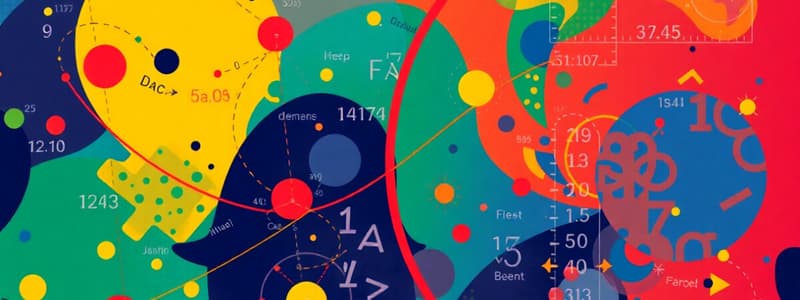Podcast
Questions and Answers
What is the probability of picking a red apple from a collection of 2 red apples and 8 green apples?
What is the probability of picking a red apple from a collection of 2 red apples and 8 green apples?
In what scenario would you use multiplication to find the probability?
In what scenario would you use multiplication to find the probability?
Why does the probability of succeeding in multiple independent tries decrease?
Why does the probability of succeeding in multiple independent tries decrease?
When are events considered dependent in probability?
When are events considered dependent in probability?
Signup and view all the answers
What is the general formula for probability?
What is the general formula for probability?
Signup and view all the answers
How does practice influence the probability of success for an athlete?
How does practice influence the probability of success for an athlete?
Signup and view all the answers
If an event A represents rolling a die and getting an even number, what would the favorable outcomes be?
If an event A represents rolling a die and getting an even number, what would the favorable outcomes be?
Signup and view all the answers
Why do we use division in the probability formula?
Why do we use division in the probability formula?
Signup and view all the answers
In the example of a lottery with tickets numbered 1 to 10, what are the possible outcomes?
In the example of a lottery with tickets numbered 1 to 10, what are the possible outcomes?
Signup and view all the answers
If a single die is rolled, what is the probability of rolling a 3?
If a single die is rolled, what is the probability of rolling a 3?
Signup and view all the answers
How do dependent events influence the probability of subsequent events?
How do dependent events influence the probability of subsequent events?
Signup and view all the answers
What happens to the overall probability of success when independent events are repeated?
What happens to the overall probability of success when independent events are repeated?
Signup and view all the answers
Which situation illustrates independent events?
Which situation illustrates independent events?
Signup and view all the answers
In which scenario would the chances of success decrease due to dependency?
In which scenario would the chances of success decrease due to dependency?
Signup and view all the answers
What is a key characteristic of dependent events?
What is a key characteristic of dependent events?
Signup and view all the answers
In which scenario would you multiply probabilities?
In which scenario would you multiply probabilities?
Signup and view all the answers
What action represents the process of calculating the probability of not getting at least one '2' when rolling two dice?
What action represents the process of calculating the probability of not getting at least one '2' when rolling two dice?
Signup and view all the answers
When are probabilities added together rather than multiplied?
When are probabilities added together rather than multiplied?
Signup and view all the answers
What is the total number of outcomes in the sample space when rolling two six-sided dice?
What is the total number of outcomes in the sample space when rolling two six-sided dice?
Signup and view all the answers
Why is it sometimes easier to calculate the probability of not obtaining a specific outcome?
Why is it sometimes easier to calculate the probability of not obtaining a specific outcome?
Signup and view all the answers
What is the probability of getting at least one 2 when rolling two dice?
What is the probability of getting at least one 2 when rolling two dice?
Signup and view all the answers
How is the probability of not rolling a 2 on a single die expressed?
How is the probability of not rolling a 2 on a single die expressed?
Signup and view all the answers
Which operation is used to find the probability of at least one 2 when throwing two dice?
Which operation is used to find the probability of at least one 2 when throwing two dice?
Signup and view all the answers
Why is the probability of rolling at least one 2 not calculated by multiplying $
rac{1}{6}$ by itself for two dice?
Why is the probability of rolling at least one 2 not calculated by multiplying $ rac{1}{6}$ by itself for two dice?
Signup and view all the answers
When calculating the probability of rolling at least one 2 with two dice, which secondary concept is applied?
When calculating the probability of rolling at least one 2 with two dice, which secondary concept is applied?
Signup and view all the answers
What is the probability of rolling two even numbers and at least one 2?
What is the probability of rolling two even numbers and at least one 2?
Signup and view all the answers
How is the probability of rolling two even numbers or at least one 2 calculated?
How is the probability of rolling two even numbers or at least one 2 calculated?
Signup and view all the answers
What is the total number of possible outcomes when rolling two dice?
What is the total number of possible outcomes when rolling two dice?
Signup and view all the answers
Which of the following statements correctly describes the intersection of two events in probability?
Which of the following statements correctly describes the intersection of two events in probability?
Signup and view all the answers
What does the term 'union of events' refer to in probability?
What does the term 'union of events' refer to in probability?
Signup and view all the answers
What is the probability of drawing a blue marble second if the first drawn marble was green?
What is the probability of drawing a blue marble second if the first drawn marble was green?
Signup and view all the answers
What is the probability of drawing two green marbles without replacement?
What is the probability of drawing two green marbles without replacement?
Signup and view all the answers
What is the main characteristic of dependent events in probability?
What is the main characteristic of dependent events in probability?
Signup and view all the answers
If a box initially contains 10 marbles, and 3 are blue, what is the probability of drawing a blue marble first?
If a box initially contains 10 marbles, and 3 are blue, what is the probability of drawing a blue marble first?
Signup and view all the answers
When calculating the probability of two dependent events, what is the correct formula to use?
When calculating the probability of two dependent events, what is the correct formula to use?
Signup and view all the answers
What method is used to simplify the calculation of the probability of getting at least one '2' when rolling two dice?
What method is used to simplify the calculation of the probability of getting at least one '2' when rolling two dice?
Signup and view all the answers
When rolling a six-sided die and flipping a coin, what is the probability of rolling a '5' and landing heads?
When rolling a six-sided die and flipping a coin, what is the probability of rolling a '5' and landing heads?
Signup and view all the answers
Why is the multiplication formula for independent events not applicable when drawing marbles without replacement?
Why is the multiplication formula for independent events not applicable when drawing marbles without replacement?
Signup and view all the answers
What is the probability of not getting a '2' on a single roll of a die?
What is the probability of not getting a '2' on a single roll of a die?
Signup and view all the answers
Which statement about dependent events is accurate?
Which statement about dependent events is accurate?
Signup and view all the answers
Study Notes
Probability Formulas and Concepts
- Probability: Represents the proportion of favorable outcomes to total possible outcomes.
- General Formula: P(A) = Number of favorable outcomes / Number of possible outcomes. This applies when outcomes are equally likely.
- Alternative Formula (Unequal Probabilities): P(A) = Σ P(ω) for each ω in A, where P(ω) is the probability of each individual outcome in event A.
- Favorable Outcomes: Results that fulfill the event you're interested in.
- Possible Outcomes: All potential results of an experiment.
- Division: The formula divides favorable outcomes by total possible outcomes to find the proportion. Normalizes the favorable outcomes.
- Multiplication: Used when combining two or more independent events to calculate the probability of both occurring. Event A does not depend on event B.
- Independent Events: The outcome of one event does not influence the outcome of another. The probability of both occurring is the product of their individual probabilities. Probability of A and B = P(A) × P(B).
- Dependent Events: The outcome of one event influences the outcome of another. For example, drawing marbles from a bag without replacement. Probability of event A and B = P(A) × P(B | A) where P(B|A) is the probability of B occurring given A has occurred. Probability of A and B.
- Complement Rule: Finds the probability of the opposite event by subtracting the probability of that event from 1. Useful in "at least one" problems where calculating the directly favorable outcome is complex.
- Union: The combination of two or more events. The outcomes in the union include every outcome in either event A or B or both events. P(A ∪ B) = P(A) + P(B) - P(A ∩ B). (Use this when dealing with an "or" statement)
Intersection (A ∩ B)
- Intersection: The events A and B that happen together. Computed by directly finding the common outcomes to both events.
- Independent Intersection: Computed by multiplying the probabilities P(A∩B)= P(A) × P(B).
- Dependent Intersection: Computed by multiplying P(A) by the probability of B given A already happened: P(A ∩ B) = P(A) × P(B | A).
Mutually Exclusive vs. Non-Mutually Exclusive
- Mutually Exclusive Events: Events that cannot occur simultaneously. In these cases, you sum the probabilities. P(A ∪ B) = P(A) + P(B)
- Non-Mutually Exclusive Events: Events that can occur simultaneously. The probability of their union must account for the overlap, so subtract the intersection's probability. P(A ∪ B) = P(A) + P(B) - P(A ∩ B)
Sample Space
- Represents all possible outcomes.
- Calculated by considering the individual possible outcomes and multiplying them
- Visualizing the total possibilities can be easier using a visual tool such as a tree diagram
Probability Example
- 1 die and 1 coin:
- Sample space is 12 (6 outcomes for die x 2 outcomes for toss)
- Probability of a 2 and Heads: 1/12
- Probability of a number greater or equal than 2 and heads: 5/12
Studying That Suits You
Use AI to generate personalized quizzes and flashcards to suit your learning preferences.
Description
Explore the essential formulas and concepts of probability. This quiz covers favorable outcomes, possible outcomes, and how to calculate probabilities using both general and alternative formulas. Perfect for students looking to deepen their understanding of probability theory.




